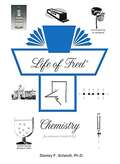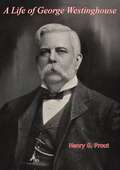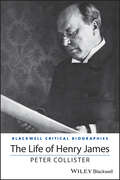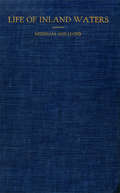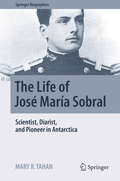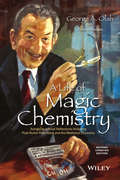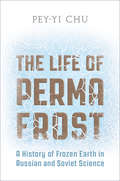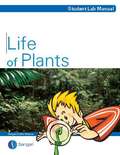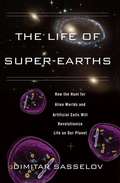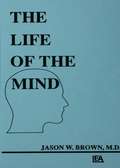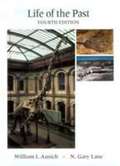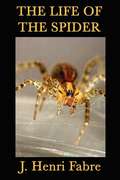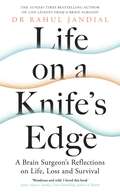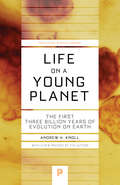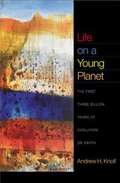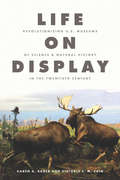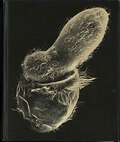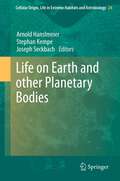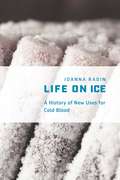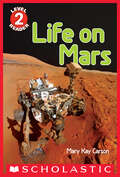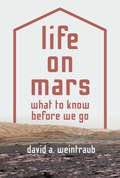- Table View
- List View
Life of Fred Chemistry
by Stanley F. SchmidtThis is the high school chemistry course that I wish I had when I was first studying chemistry. Several studies have shown that students who have had a high school chemistry course--like this book--do much better learning college-level chemistry. <p><p>The TRADITIONAL WAY to teach chem (and math and physics and biology) is have the student memorize thousands of facts. Some chem textbooks are like telephone books. One of them is actually 1200 pages long and costs more than $200. If you were teaching chem to a computer, this approach would be perfect. Computers can memorize (and retain) a million facts without breaking into a sweat.
A Life of George Westinghouse
by Henry G. ProutGEORGE WESTINGHOUSE the man may be overshadowed by his inventions, company, or legend. But in this biography by Henry G. Prout, Westinghouse's personal life and history are recounted along with his many inventions and enterprises -- and his inventions and enterprises were enormous. "He dealt in the same week, and often in the same day, with organization, financial and executive affairs, commercial affairs, and the engineering details of half a dozen companies in two hemispheres," Prout noted. "They were as far apart in kind as the air brake and natural gas, and as far apart in geography as San Francisco and St. Petersburg." This biography covers topics as diverse as power signaling and switching, Westinghouse's use of the alternating current, his activities at Niagara Falls, his European enterprises, his financial methods, and his overall impact on rail transportation and the power industry.-Print ed.
The Life of Henry James: A Critical Biography (Wiley Blackwell Critical Biographies)
by Peter CollisterDiscover anew the life and influence of Henry James, part of the acclaimed Wiley Blackwell Critical Biographies series. In The Life of Henry James: A Critical Biography, Peter Collister, an established critic and authority on Henry James, offers an original and fully documented account of one of America’s finest writers, who was both a creative practitioner and theorist of the novel. In this volume, James’s life in all its personal and cultural richness is examined alongside a detailed scrutiny of his fiction, essays, biographies, autobiographies, travel writing, plays and reviews. James was a dedicated and brilliant letter-writer and his biographer make judicious use of this material, some of it previously unpublished, evoking in the novelist’s own words the society within which he moved and worked. His gift for friendship, often resulting in close relationships with both men and women, are sensitively explored. Near the beginning of his long and highly productive life, James left America to immerse himself in European culture and history – a necessity, he felt, for the developing artist. In an ironic symmetry he witnessed in his youth the effects of the American Civil War and in his last days, finally becoming a British citizen, despaired at the unfolding tragedy of the Great War in Europe. Sustained, nevertheless, by his own creative energy, he never ceased to believe in the capacity of the arts to enhance and give significance to life. Provides well-informed accounts of Henry James’s youth in New York City, his unconventional education, his extensive travel in Europe, his eventual assimilation into British society, his development as a writer and his personal relationships as a single man. Features discussions of James’s major works in a variety of genres from an assured theoretical and historical perspective. Assesses James’s developing quest for dramatic form in his fiction – the ‘scenic art’ – as well as his critical writing which was to have a lasting influence on the literature and aesthetic values of the twentieth century. Discusses his achieved aspiration to be ‘just literary’, to become what he called that ‘queer monster’, an artist. Charts James’s lifelong interest in art and theatre. An incisive discussion of the life of an author of major stature, The Life of Henry James: A Critical Biography offers a refreshingly lucid and human account of a novelist and his often challenging, but rewarding, writing. Peter Collister, a former college Assistant Principal, has published many essays in Europe and America on a range of nineteenth-century British and French authors. He is the author of Writing the Self: Henry James and America and later edited for the university presses of Cambridge and Virginia the award-winning volumes: The Complete Writings of Henry James on Art and Drama, James's autobiographical writings, A Small Boy and Others, Notes of a Son and Brother, and The Middle Years, as well as The American Scene.
Life of Inland Waters: An Elementary Text Book of Fresh-Water Biology For Students
by James G. NeedhamThis work is a textbook of fresh-water life dealing with its forms, its conditions, its fitnesses, its associations, and its economic aspects. The ecologic side of fresh-water biology is emphasized. Due consideration is given to the educational, economic, sanitary, social, civic, and aesthetic aspects of the subject.Limnology in America today is in its infancy. The value of its past achievements is just beginning to be appreciated. The benefits to come from a more intensive study of water life arc just beginning to be disclosed. That there is a widespread interest is already manifest in the large number of biological stations at which limnological work is being done.We recommend this volume as a general introduction to all students and teachers of this subject.
The Life of Isaac Newton
by Richard S. WestfallIsaac Newton was indisputably one of the greatest scientists in history. His achievements in mathematics and physics marked the culmination of the movement that brought modern science into being. Richard Westfall's biography captures in engaging detail both his private life and scientific career, presenting a complex picture of Newton the man, and as scientist, philosopher, theologian, alchemist and public figure, President of the Royal Society and Warden of the Royal Mint. An abridged version of his magisterial study Never at Rest, this concise biography is now published for the first time in paperback and makes Westfall's highly acclaimed portrait of Newton newly accessible to general readers.
The Life of José María Sobral
by Mary R. TahanFeaturing the previously unpublished diary of José María Sobral, Under-Lieutenant of the Argentine Navy, this book provides insight on his life and his participation in Otto Nordenskjöld's Swedish Antarctic Expedition of 1901-1903.This biography highlights Sobral's personal thoughts on the mission, his position, the science being discovered, and the geopolitical situation around him. The reader also learns about the state of science, Antarctic exploration, and cultural-political-issues at that time. The author's critical and contextual analysis of the diary explains more about Sobral and his role in Argentina, Antarctica, science and history. This paints a detailed picture of Sobral as an individual, and provides the framework to depict the world in which Sobral lived and worked as well as his expedition and accomplishments. The book aims to explain the context of Sobral's writings, the significance of the events he described in his diary entries, and the way all of these events tied into history and scientific discovery.
A Life of Magic Chemistry
by George A. Olah Thomas MathewThe autobiography of a Nobel Prize winner, this book tells us about George Olah's fascinating research into extremely strong superacids and how it yielded the common term "magic acids." Olah guides us through his long and remarkable journey, from Budapest to Cleveland to Los Angeles, with a stopover in Stockholm. This updated autobiography of a Nobel Prize winner George A. Olah: Chronicles the distinguished career of a chemist whose work in a broad range of chemistry areas, and most notably that in methane chemistry, led to technologies that impact the processing and utility of alternative fuels Is based on Olah's work on extremely strong superacids and how they yielded the common term, "magic acids" Details events since the publication of the first edition in 2000 Inspires readers with details on Dr. Olah's successful recent research on methane, intended to help provide a solution to "the oil problem" ical" carbocations - such as the norbornyl cation, which can be depicted as cationic character delocalized over several bonds. In recent years, his research has shifted from hydrocarbonsand their transformation into fuel to the methanol economy. He has joined with Robert Zubrin, Anne Korin, and James Woolsey in promoting a flexible-fuel mandate initiative.
The Life of Permafrost: A History of Frozen Earth in Russian and Soviet Science
by Pey-Yi ChuIn the Anthropocene, the thawing of frozen earth due to global warming has drawn worldwide attention to permafrost. Contemporary scientists define permafrost as ground that maintains a negative temperature for at least two years. But where did this particular conception of permafrost originate, and what alternatives existed? The Life of Permafrost provides an intellectual history of permafrost, placing the phenomenon squarely in the political, social, and material context of Russian and Soviet science. Pey-Yi Chu shows that understandings of frozen earth were shaped by two key experiences in the Russian Empire and the Soviet Union. On one hand, the colonization and industrialization of Siberia nourished an engineering perspective on frozen earth that viewed the phenomenon as an aggregate physical structure: ground. On the other, a Russian and Soviet tradition of systems thinking encouraged approaching frozen earth as a process, condition, and space tied to planetary exchanges of energy and matter. Aided by the US militarization of the Arctic during the Cold War, the engineering view of frozen earth as an obstacle to construction became dominant. The Life of Permafrost tells the fascinating story of how permafrost came to acquire life as Russian and Soviet scientists studied, named, and defined it.
The Life of Super-Earths: How the Hunt for Alien Worlds and Artificial Cells Will Revolutionize Life on Our Planet
by Dimitar SasselovIn 1543, Nicolaus Copernicus fomented a revolution when he debunked the geocentric view of the universe, proving instead that our planet wasn’t central to the universe. Almost five hundred years later, the revolution he set in motion is nearly complete. Just as earth is not the center of things, the life on it, it appears, is not unique to the planet. Or is it? The Life of Super-Earthsis a breathtaking tour of current efforts to answer the age-old question: Are we alone in the universe? Astronomer Dimitar Sasselov, the founding director of Harvard University’s Origins of Life Initiative, takes us on a fast-paced hunt for habitable planets and alien life forms. He shows how the search for “super-Earths”-rocky planets like our own that orbit other stars-may provide the key to answering essential questions about the origins of life here and elsewhere. That is, if we don’t find the answers to those questions here first. As Sasselov and other astronomers have uncovered planets with mixes of elements different from our own, chemists have begun working out the heretofore unseen biochemistries that those planets could support. That knowledge is feeding directly into synthetic biology-the effort to build wholly novel forms of life-making it likely that we will first discover truly “alien” life forms in an earthly lab, rather than on a remote planet thousands of light years away. Sasselov tells the gripping story of a moment of unprecedented potential-a convergence of pioneering efforts in astronomy and biology to peer into the unknown. The Life of Super-Earthsoffers nothing short of a transformation in our understanding of life and its place in the cosmos.
The Life of the Mind (Comparative Cognition and Neuroscience Series)
by Jason W. BrownThis detailed look at the development of microgenetic theory provides a comprehensive and coherent model of cognitive processing in the brain, based on patterns of breakdown in pathology. In so doing, it illustrates the clinical record that supports and documents microgenetic theory, and presents a basis for future work in the study of the brain. Coverage includes topics in language and dominance, the function of the right hemisphere, action, perception, memory, and the concept of time.
Life of the Past (4th Edition)
by William I. Ausich N. Gary LaneA comprehensive introduction to the history of life on Earth.
The Life of the Spider
by J. Henri FabreFabre had many scholarly achievements. He was a popular teacher, physicist, chemist, and botanist. However, he is probably best known for his findings in the field of entomology, the study of insects, and is considered by many to be the father of modern entomology.
Life on a Knife’s Edge: A Brain Surgeon’s Reflections on Life, Loss and Survival
by Dr Rahul Jandial'It's a brilliant book... There are lessons in every paragraph... Get it now.' Chris Evans'Wonderous and wild. I loved this book' James Nestor, bestselling author of Breath 'Moving, raw and unflinching' Julia Samuel, bestselling author of This Too Shall Pass'Incredible storytelling' Dr Rangan Chatterjee, bestselling author of Feel Better in 5____________________________________________________________________________How do you carry on when things go deadly wrong?When Dr Rahul Jandial operated on Karina, an eleven-year-old girl whose spinal cord was splitting in two, he had to make an impossible decision. He followed his head over his gut and Karina was left permanently paralysed, altering both patient and surgeon's lives for ever. This decision would haunt Rahul for decades, a constant reminder of the fine line between saving and damaging a life.As one of the world's leading brain surgeons, Rahul is the last hope for patients with extreme forms of cancer. In treating them, he has observed humanity at its most raw and most robust. He has journeyed to unimaginable extremes with them, guiding them through the darkest moments of their lives.Life on a Knife's Edge is Rahul's poetic and beautifully written account of the resilience, courage and belief he has witnessed in his patients, and the lessons about human nature he has learned from them. It is about the impossible choices he has to make, and the fateful consequences he is forced to live with.From challenging the ethics of surgical practices, to helping a patient with locked-in syndrome communicate her dying wish to her family, Rahul shares his extraordinary experiences, revealing the depths of a surgeon's psyche that is continuously pushed to its limits.
Life on a Young Planet: The First Three Billion Years of Evolution on Earth
by Andrew H. KnollAustralopithecines, dinosaurs, trilobites--such fossils conjure up images of lost worlds filled with vanished organisms. But in the full history of life, ancient animals, even the trilobites, form only the half-billion-year tip of a nearly four-billion-year iceberg. Andrew Knoll explores the deep history of life from its origins on a young planet to the incredible Cambrian explosion, presenting a compelling new explanation for the emergence of biological novelty. The very latest discoveries in paleontology--many of them made by the author and his students--are integrated with emerging insights from molecular biology and earth system science to forge a broad understanding of how the biological diversity that surrounds us came to be. Moving from Siberia to Namibia to the Bahamas, Knoll shows how life and environment have evolved together through Earth's history. Innovations in biology have helped shape our air and oceans, and, just as surely, environmental change has influenced the course of evolution, repeatedly closing off opportunities for some species while opening avenues for others. Readers go into the field to confront fossils, enter the lab to discern the inner workings of cells, and alight on Mars to ask how our terrestrial experience can guide exploration for life beyond our planet. Along the way, Knoll brings us up-to-date on some of science's hottest questions, from the oldest fossils and claims of life beyond the Earth to the hypothesis of global glaciation and Knoll's own unifying concept of ''permissive ecology.'' In laying bare Earth's deepest biological roots, Life on a Young Planet helps us understand our own place in the universe--and our responsibility as stewards of a world four billion years in the making. In a new preface, Knoll describes how the field has broadened and deepened in the decade since the book's original publication.
Life on a Young Planet: The First Three Billion Years of Evolution on Earth
by Andrew H. KnollThe author presents a compelling new explanation for the evolution as he takes us deep into history of life, thereby helping readers understand how the biological diversity that surrounds us, came to existence.
Life on Display: Revolutionizing U.S. Museums of Science and Natural History in the Twentieth Century
by Karen A. Rader Victoria E. M. CainRich with archival detail and compelling characters, Life on Display uses the history of biological exhibitions to analyze museums’ shifting roles in twentieth-century American science and society. Karen A. Rader and Victoria E. M. Cain chronicle profound changes in these exhibitions--and the institutions that housed them--between 1910 and 1990, ultimately offering new perspectives on the history of museums, science, and science education. Rader and Cain explain why science and natural history museums began to welcome new audiences between the 1900s and the 1920s and chronicle the turmoil that resulted from the introduction of new kinds of biological displays. They describe how these displays of life changed dramatically once again in the 1930s and 1940s, as museums negotiated changing, often conflicting interests of scientists, educators, and visitors. The authors then reveal how museum staffs, facing intense public and scientific scrutiny, experimented with wildly different definitions of life science and life science education from the 1950s through the 1980s. The book concludes with a discussion of the influence that corporate sponsorship and blockbuster economics wielded over science and natural history museums in the century’s last decades. A vivid, entertaining study of the ways science and natural history museums shaped and were shaped by understandings of science and public education in the twentieth-century United States, Life on Display will appeal to historians, sociologists, and ethnographers of American science and culture, as well as museum practitioners and general readers.
Life on Display: Revolutionizing U.S. Museums of Science and Natural History in the Twentieth Century
by Karen A. Rader Victoria E.M. CainRich with archival detail and compelling characters, Life on Display uses the history of biological exhibitions to analyze museums’ shifting roles in twentieth-century American science and society. Karen A. Rader and Victoria E. M. Cain chronicle profound changes in these exhibitions—and the institutions that housed them—between 1910 and 1990, ultimately offering new perspectives on the history of museums, science, and science education. Rader and Cain explain why science and natural history museums began to welcome new audiences between the 1900s and the 1920s and chronicle the turmoil that resulted from the introduction of new kinds of biological displays. They describe how these displays of life changed dramatically once again in the 1930s and 1940s, as museums negotiated changing, often conflicting interests of scientists, educators, and visitors. The authors then reveal how museum staffs, facing intense public and scientific scrutiny, experimented with wildly different definitions of life science and life science education from the 1950s through the 1980s. The book concludes with a discussion of the influence that corporate sponsorship and blockbuster economics wielded over science and natural history museums in the century’s last decades. A vivid, entertaining study of the ways science and natural history museums shaped and were shaped by understandings of science and public education in the twentieth-century United States, Life on Display will appeal to historians, sociologists, and ethnographers of American science and culture, as well as museum practitioners and general readers.
Life on Earth and other Planetary Bodies
by Joseph Seckbach Arnold Hanslmeier Stephan KempeA trio of editors [Professors from Austria, Germany and Israel] present Life on Earth and other Planetary Bodies. The contributors are from twenty various countries and present their research on life here as well as the possibility for extraterrestrial life. This volume covers concepts such as life's origin, hypothesis of Panspermia and of life possibility in the Cosmos. The topic of extraterrestrial life is currently 'hot' and the object of several congresses and conferences. While the diversity of "normal" biota is well known, life on the edge of the extremophiles is more limited and less distributed. Other subjects discussed are Astrobiology with the frozen worlds of Mars, Europa and Titan where extant or extinct microbial life may exist in subsurface oceans; conditions on icy Mars with its saline, alkaline, and liquid water which has been recently discovered; chances of habitable Earth-like [or the terrestrial analogues] exoplanets; and SETI's search for extraterrestrial Intelligence.
Life on Ice: A History of New Uses for Cold Blood
by Joanna RadinAfter the atomic bombing at the end of World War II, anxieties about survival in the nuclear age led scientists to begin stockpiling and freezing hundreds of thousands of blood samples from indigenous communities around the world. These samples were believed to embody potentially invaluable biological information about genetic ancestry, evolution, microbes, and much more. Today, they persist in freezers as part of a global tissue-based infrastructure. In Life on Ice, Joanna Radin examines how and why these frozen blood samples shaped the practice known as biobanking. The Cold War projects Radin tracks were meant to form an enduring total archive of indigenous blood before it was altered by the polluting forces of modernity. Freezing allowed that blood to act as a time-traveling resource. Radin explores the unique cultural and technical circumstances that created and gave momentum to the phenomenon of life on ice and shows how these preserved blood samples served as the building blocks for biomedicine at the dawn of the genomic age. In an era of vigorous ethical, legal, and cultural debates about genetic privacy and identity, Life on Ice reveals the larger picture—how we got here and the promises and problems involved with finding new uses for cold human blood samples.
Life on Mars (Scholastic Reader, Level 2)
by Mary Kay CarsonDiscover the truth about life on Mars in this level 2 reader!Mars is a cold, desert planet with no water. But it wasn't always like this. Could there once have been living things there? Find out in this new level 2 reader all about life on Mars. Includes the most stunning and up-to-date photographs from NASA.
Life on Mars: What to Know Before We Go
by David WeintraubThe story of the search for life on Mars—and the moral issues confronting us as we prepare to send humans thereDoes life exist on Mars? The question has captivated humans for centuries, but today it has taken on new urgency. NASA plans to send astronauts to Mars orbit by the 2030s. SpaceX wants to go by 2024, while Mars One wants to land a permanent settlement there in 2032. As we gear up for missions like these, we have a responsibility to think deeply about what kinds of life may already inhabit the planet--and whether we have the right to invite ourselves in. This book tells the complete story of the quest to answer one of the most tantalizing questions in astronomy. But it is more than a history. Life on Mars explains what we need to know before we go.David Weintraub tells why, of all the celestial bodies in our solar system, Mars has beckoned to us the most. He traces how our ideas about life on Mars have been refined by landers and rovers, terrestrial and Mars-orbiting telescopes, spectroscopy, and even a Martian meteorite. He explores how finding DNA-based life on the Red Planet could offer clues about our distant evolutionary past, and grapples with the profound moral and ethical questions confronting us as we prepare to introduce an unpredictable new life form—ourselves—into the Martian biosphere.Life on Mars is also a book about how science is done—and undone—in the age of mass media. It shows how Mars mania has obscured our vision since we first turned our sights on the planet and encourages a healthy skepticism toward the media hype surrounding Mars as humanity prepares to venture forth.

